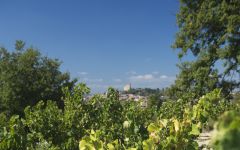Roger Perrin Chateauneuf-du-Pape Blanc 2021
-
Robert
Parker - Vinous



Product Details
Your Rating
Somm Note
Winemaker Notes
These grapes are vinified separately, pressed directly, and fermented sur lie. The Roussanne is vinified in new oak. After its alcoholic fermentation, its lees are stirred a couple of times a week for 7 months. The other grapes are raised in temperature controlled stainless steel vats, where they harmonize until the final blend.
Professional Ratings
-
Robert Parker's Wine Advocate
A partially barrel-fermented blend of 40% Grenache Blanc, 30% Clairette, 20% Roussanne, 7% Picardan and 3% Bourboulenc, Perrin's 2021 Chateauneuf du Pape Blanc is perhaps his finest to date. Scents of tangerine, stone fruit and anise appear on the nose, while the medium to full-bodied palate is plump and fleshy yet not overdone, finishing clean, crisp and refreshing.
-
Vinous
The 2021 Châteauneuf-du-Pape Blanc shimmers with straw reflections. It unfurls aromas of jasmine, pear, quince, lemon flesh, white peach, cedar and freshly-cut fennel. Medium to full- bodied, well-balanced and showing good energy, the finish of the 2021 Blanc is juicy and leaves a salty aftertaste.
Other Vintages
2019- Vinous






Vineyards have existed on the Roger Perrin property between Orange and Châteauneuf since the beginning of the 1900’s. However, the Domaine Roger Perrin was founded in 1969 when Roger Perrin took it over after his father-in-law's retirement. Roger died unexpectedly during the harvest in 1986, and his son Luc took over the Domaine. Luc had studied enology and done an apprenticeship at Château de Beaucastel, which is managed by another family named Perrin. Slowly Luc Perrin increased the quality at his Domaine so that people began to recognize his name as a producer rather than mistakenly as one of the "Beaucastel Perrins." The two families, although neighbors and friends, actually have no genetic ties.
Sadly, Luc also died young in 2010, and his oldest sister Veronique took over for a time. She subsequently passed control of the Domaine to her son Xavier, who today, as the 5th generation working the land here, is proudly continuing Luc’s viticultural and vinification practices.
Perrin's holdings include 40 hectares of vineyards, spread out over 70 different plots. While some of the vines are more than 100 years old, the average age of the vines is 60 years old and 85% of the vines are over 20 years of age. The Châteauneuf vines are planted on two types of soil: clay and limestone subsoil covered by the galets roulés (so familiar to anyone who has seen Châteauneuf vineyards), and a sandier soil which gives wines that show a little more aromatic and tannic finesse.?
Perrin also makes a few excellent Côtes du Rhônes coming from two different soil types: sand with some large stones (somewhat like the second type of Châteauneuf soil) and red limestone sitting upon a bed of gravel (giving fruity and round results).
All of the wines are made by Xavier in the highly traditional manner of his forebears: harvests are done by hand and most of the wines, whether co-fermented or vinified separately, are aged only in stainless steel vats. Whites undergo some stirring of the lees. Destemming is done in varying percentages but in some cases is 100%. The Châteauneuf-level wines are raised in a combination of foudre, enamel-lined tanks and barrique.
The level of quality of the Domaine is evident, as is their dedication to preserving tradition and regional character. Recognition was hard-won but is now theirs to enjoy, and the Domaine has been called a new star in Châteauneuf-du-Pape in Robert Parker's Wine Advocate.

Full-bodied and flavorful, white Rhône blends originate from France’s Rhône Valley. Today these blends are also becoming popular in other regions. Typically some combination of Grenache Blanc, Marsanne, Roussanne and Viognier form the basis of a white Rhône blend with varying degrees of flexibility depending on the exact appellation. Somm Secret—In the Northern Rhône, blends of Marsanne and Roussanne are common but the south retains more variety. Marsanne, Roussanne as well as Bourboulenc, Clairette, Picpoul and Ugni Blanc are typical.

Famous for its full-bodied, seductive and spicy reds with flavor and aroma characteristics reminiscent of black cherry, baked raspberry, garrigue, olive tapenade, lavender and baking spice, Châteauneuf-du-Pape is the leading sub-appellation of the southern Rhône River Valley. Large pebbles resembling river rocks, called "galets" in French, dominate most of the terrain. The stones hold heat and reflect it back up to the low-lying gobelet-trained vines. Though the galets are typical, they are not prominent in every vineyard. Chateau Rayas is the most obvious deviation with very sandy soil.
According to law, eighteen grape varieties are allowed in Châteauneuf-du-Pape and most wines are blends of some mix of these. For reds, Grenache is the star player with Mourvedre and Syrah coming typically second. Others used include Cinsault, Counoise and occasionally Muscardin, Vaccarèse, Picquepoul Noir and Terret Noir.
Only about 6-7% of wine from Châteauneuf-du-Pape is white wine. Blends and single-varietal bottlings are typically based on the soft and floral Grenache Blanc but Clairette, Bourboulenc and Roussanne are grown with some significance.
The wine of Chateauneuf-du-Pape takes its name from the relocation of the papal court to Avignon. The lore says that after moving in 1309, Pope Clément V (after whom Chateau Pape-Clément in Pessac-Léognan is named) ordered that vines were planted. But it was actually his successor, John XXII, who established the vineyards. The name however, Chateauneuf-du-Pape, translated as "the pope's new castle," didn’t really stick until the 19th century.
